Understanding the Qur’an in Tarawih Application
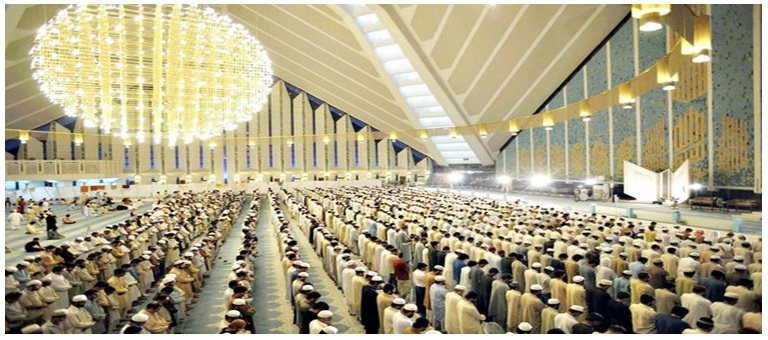
In this article, DR. SAMEEN AHMED KHAN summarizes the divisions of the Holy Qur’an along with the occurrence of the Sajdah Tilawat and the Muqatta’at. These distinct Ayahs enable us to recognize the portion of the Holy Qur’an being recited. The approach to the Qur’anic Arabic through the Qur’anic Words is briefly mentioned. The information given in the article is expected to assist in our preparation for the understanding of the Tarawih.
Introduction
The Holy Qur’an was revealed in the auspicious month of Ramadan. This auspicious month is marked with Siyam (fasting) and special Salaat (prayers) namely the Tarawih Salaat. For many of us who do not know the Holy Qur’an by heart, find it difficult to follow the Tarawih: both its contents and meaning. Some information about the organization of the Qur’an can assist us in following the Tarawih. This short note is an attempt to familiarize us with the organization of the Holy Qur’an.
“Hence, indeed, We made this Qur’an easy to bear in mind: who, then, is willing to take it to heart?” (Surah Qamar, 54: 17, 22, 32, 40) [English Meaning by Muhammad Asad, from http://www.IslamiCity.com/]
Divisions of the Holy Qur’an
The Holy Qur’an has words, Ayahs or signs and the Surahs. The word, Ayah (singular is Ayat), is generally translated as ‘verses’. An Ayah may consist of a full sentence, more than one sentence, or part of a sentence. There are different conventions of counting the total number of Ayah. For instance, the Bismillah before each Surah may, or may not, be counted. This leads to a difference in the figures arrived for the total number of Ayah in the Holy Qur’an. The count varies from 6239 to 6666. A group of Ayahs make a Surah. There are exactly 114 Surahs in the Holy Qur’an. Three of the 114 Surahs have three Ayah each, which are: Surah-103: the Al-Asr; Surah-108: the Al-Kauthar; and Surah-110: the Al-Nasr. Surah-2: the Al-Baqarah is the largest and has 286 Ayahs.
For referring to a particular Ayat, the method has been given to us by the Sunnah of the Prophet Muhammad (peace be upon him), that is Surah and Ayat. Since all Surah and Ayat within them are numbered, the most scientific method is to provide the Surah and Ayah numbers. For example, Ayat-al-Kursi is 2: 255, that is Surah 2 (Al-Baqarah) and Ayah 255. Some scholars prefer the reference, ‘Al-Baqarah 255’ or ‘Al-Baqarah (2): 255.’
Scholars after the Prophet (peace be upon him) have done additional division of the Holy Qur’an for the convenience of recitation of the whole Qur’an in a set period like one week or one month. The seven approximately equal divisions are called Manzils or stations.

The 30 equal parts of the Holy Qur’an are called Juz or Para (words Sipara and Paro are also used). There is more than one way of dividing the Juz. Each Juz is divided into two Hizb (group) and each Hizb is further divided into four quarters. Thus, a Juz has two Hizb and eight Hizb-quarters. In this system of division, the whole Qur’an is divided into 240 Hizb-quarters. This allows a person to recite the Holy Qur’an in small groups of verses and complete the recitation in one-month to eight-month periods.
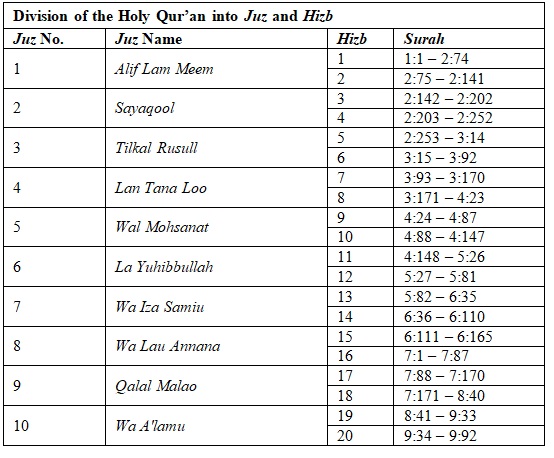
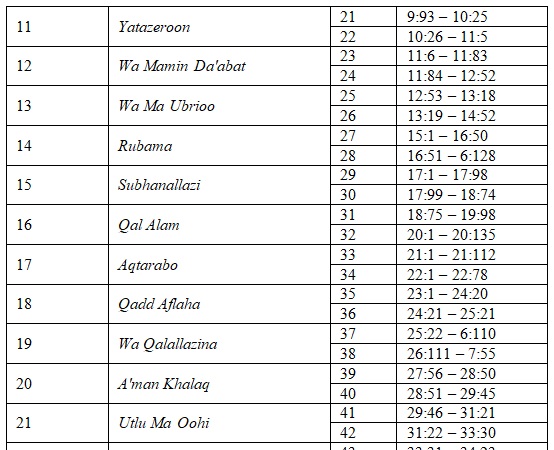
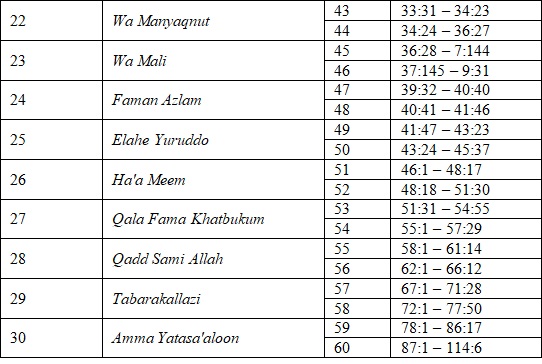
Another widely used division is the Ruku (meaning bowing or section). The Qur’an is divided into the Surah al-Fatiha and 540 Ruku. The Ruku have unequal lengths and are a logical point in the science of recitation. With twenty Ruku a day, it takes 27 days to complete the recitation of the Holy Qur’an. This is the pattern generally followed in the 20 Rakaat Tarawih. The Hizb division is more suited for the 8 Rakaat Tarawih, completing the recitation of the Holy Qur’an in 30 days. The Ruku markings are widely used in the prints from the Indian subcontinent. The Hizb marking are common in the prints obtained from the Arab world.
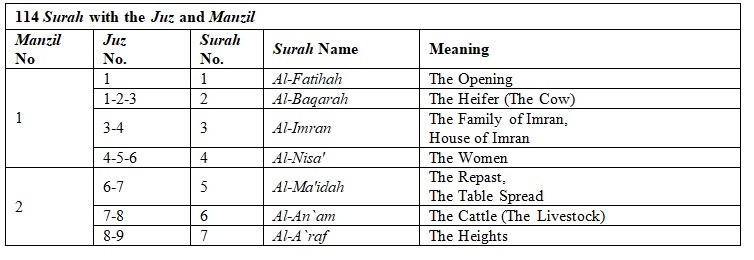
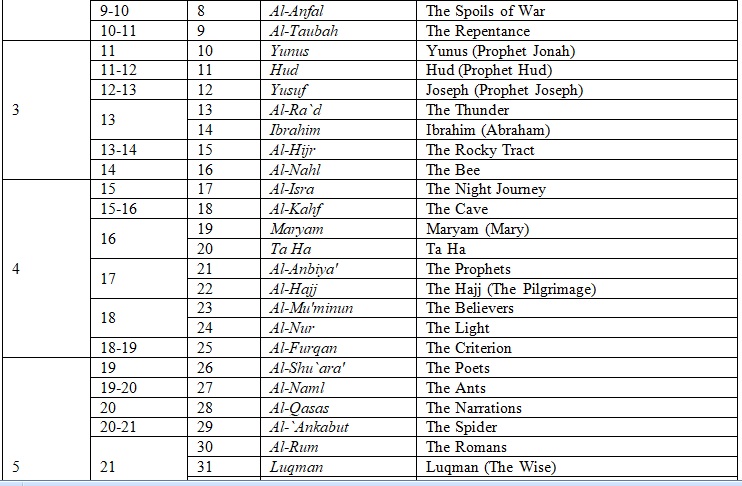

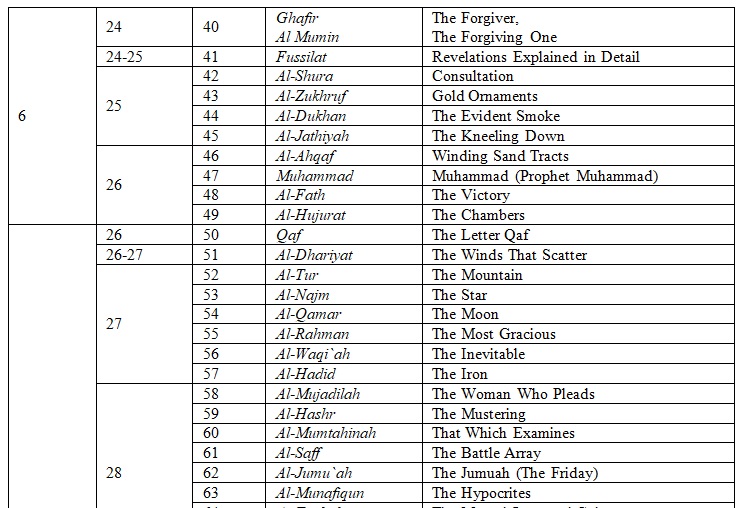
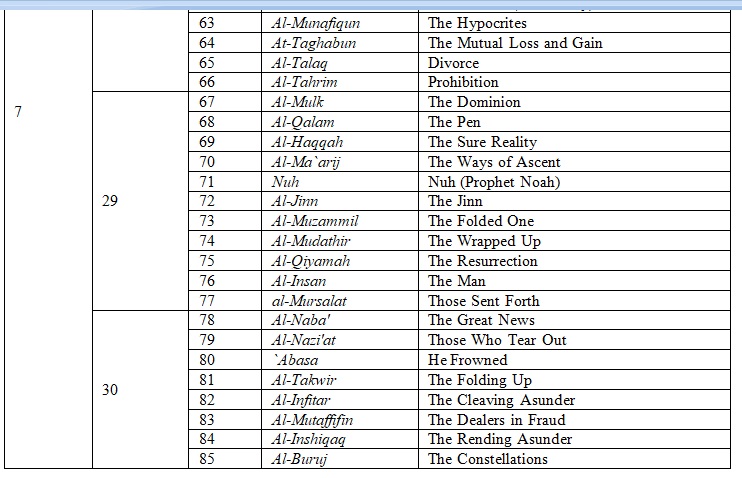
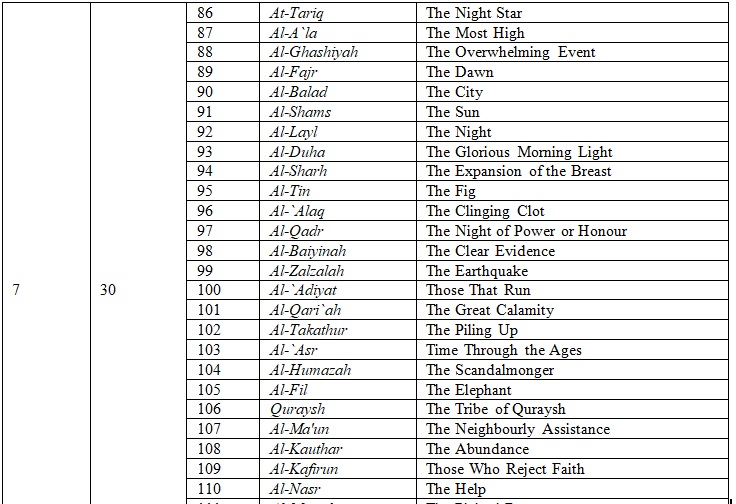

Many of the 114 Surahs have more than one name or title. A detailed understanding of the meaning of the titles of the Surah is obtained from the introduction to that Surah as given in any standard Tafsir of the Holy Qur’an (Commentaries and Exegesis).
Sajdah Tilawat
 There are some specific Ayah giving the command to make Sajdah (prostration) or mention that the believers prostrate before Allah in submission to Him. As a response to these Ayahs, it is required, according to the Sunnah of the Prophet (peace be upon him) to make Sajdah whenever one reads, recites from memory, or hears any of these Ayah. This is a Sunnah Mu’akkadah and it should not be omitted. These are known as the Sajdah of Tilawat (prostration of recitation). There are fourteen (according to some jurists, fifteen) places in the whole Qur’an, where the Ayah of Sajdah occur.
There are some specific Ayah giving the command to make Sajdah (prostration) or mention that the believers prostrate before Allah in submission to Him. As a response to these Ayahs, it is required, according to the Sunnah of the Prophet (peace be upon him) to make Sajdah whenever one reads, recites from memory, or hears any of these Ayah. This is a Sunnah Mu’akkadah and it should not be omitted. These are known as the Sajdah of Tilawat (prostration of recitation). There are fourteen (according to some jurists, fifteen) places in the whole Qur’an, where the Ayah of Sajdah occur.
The location of the Sajdah Ayah clearly pointed in the text and in the margins. This is generally done using the beautiful calligraphy. If some non-Arabic publisher has missed theses markings, please make a record of them using the enclosed table. They are listed in the following table:
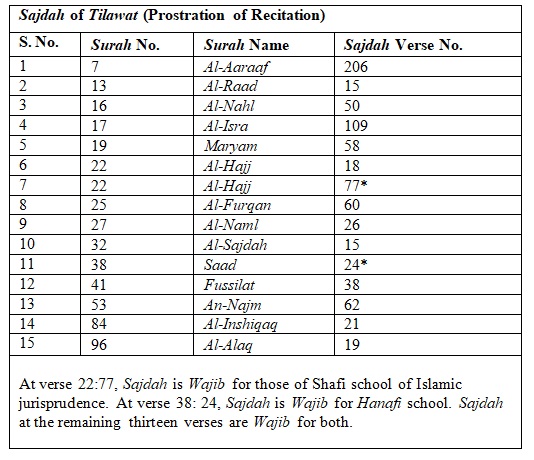
The prerequisites for this Sajdah are the same as for the Salah (Namaz or Prayer): 1. Purity of body, clothes, and place of Sajdah. 2. Covering of Satr. 3. Turning your face toward Qiblah. 4. Intention of performing the Sajdah. The procedure is: 1. Stand facing the Qiblah.  2. Express the necessary intention. 3. Go down for Sajdah with Allahu-Akbar and should recite the usual Dua, Subhana Rabbiyal-A’la. 4. Rise up with Allahu-Akbar after Sajdah.
2. Express the necessary intention. 3. Go down for Sajdah with Allahu-Akbar and should recite the usual Dua, Subhana Rabbiyal-A’la. 4. Rise up with Allahu-Akbar after Sajdah.
If an Ayat requiring the Sajdah has been recited during the Salah such as the Tarawih Salah, the Sajdah has to be performed forthwith without delay. It is obligatory to perform the Sajdah without delaying it to after the Salah. If a person hears an Ayat requiring the Sajdah, being recited by the Imam, but joins the congregation when the Imam has already performed the Sajdah, he will perform the Sajdah after completing his Salah.
If the Ayat is recited or heard outside the Salah, it is preferable to perform the Sajdah immediately afterwards, but one may perform it later as well. There is only one Sajdah required for each Ayat. If a person recites an Ayat requiring the Sajdah in the mind, but does not utter it aloud or only writes it, he will not be required to perform the Sajdah. If the Ayat requiring the Sajdah is recited over and over again (for memorizing or understanding) in the same sitting, only one Sajdah will have to be performed, but if more than one Ayah requiring Sajdah are recited, the number of Sajdah to be performed will be the same as the number of the Ayah recited. Similarly, if the Ayat requiring a Sajdah is repeated in different sittings, the number of Sajdah to be performed will be according to the number of sittings.
It is not valid to do the Sajdah on the Qur’an itself during the recitation of the Qur’an. One has to do it completely as one does it during the Salah. It is useful to memorize the complete Sajdah verses, particularly in the context of the Tarawih Salah. It is also useful when listening to the Qira’at and reading from the Qur’an without the markings of the Sajdah Ayah.
Muqatta’at
Muqatta’at literally means abbreviated letters. Muqatta’at are unique letter combinations that appear in the beginning of 29 Surahs of the Holy Qur’an. They are also known as Fawaatih, or openers, as they form the opening Ayat of the respective Surah. Their precise meanings remain unclear and are considered by most Muslims to be divine secrets. The Muqatta’at have been, and continue to be, a topic of intense research and academic discussions in Islamic literature and Qur’anic studies. The following table gives the summary of the occurrence of the Muqatta’at.
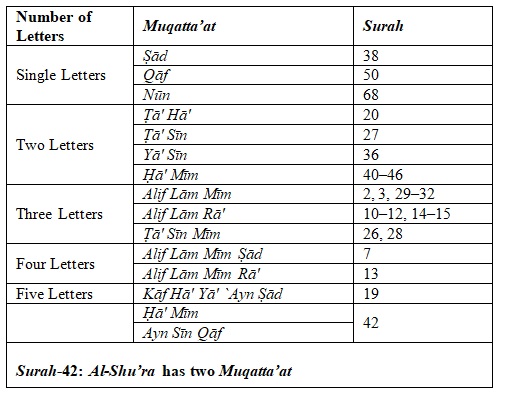
Qur’anic Words
A knowledge of the Arabic language is extremely essential to understand the Holy Qur’an, the Divine Message from our Creator and the Creator of the Universe. There are different ways to learn Arabic. The Holy Qur’an has about 6500 distinct words, which repeat, and thereby, the Qur’an has about seventy-eight thousand words. Some words repeat many times. It is useful to learn such high frequency words to build a strong vocabulary of the Qur’anic words. The additional vocabulary and the grammar will be a continuation of this basic vocabulary. The knowledge of the frequently occurring words enables us to get some understanding of what we are reciting and what the Imam is reciting. The required words lists are readily available in several languages from the references given at the end of this article.
Concluding Suggestions
Ideally, we need to memorize the complete Holy Qur’an. Knowledge of the Qur’anic divisions, the location of the Sijdah Tilawat and Muqatta’at provides us a guide in knowing the portion being recited. It is useful to individually recite about a Juz before each Tarawih.
One can also read the corresponding Tafasir or at least the Tarawih summary providing an outline of what is being recited. Such practices also improve our concentration in the Tarawih. One can also use a variety of digital Qur’an available, which assists with the recitation and the memorizing. May Allah Almighty Guide us in learning the Holy Qur’an and in practicing what it Guides each one of us to do; Aameen.
Bibliography
- A website for Qur’an-e-Majeed with comprehensive search in Arabic and numerous languages, along with several English translations (meanings), http://www.islamicity.com/mosque/Qur’an/
- Websites for Hadith, http://www.searchtruth.com/ and http://ahadith.co.uk/
- Tarawih Summaries in English, Hindi and Urdu, http://NawabMohammedAbdulGhani.webs.com/tarawih.html and http://www.ipci.co.za/information/taraweeh-Qur’an-summary/
- Shams Pirzada, Is it not necessary to read the Qur’an with Understanding?, Idara Da’watul Qur’an, Mumbai, India, 13th Edition (2011). http://scanislam.com/browse-islam/read-Qur’an-with-understanding/ and http://www.Qur’anforall.org/Qur’an/iintrqwund.htm
- Khurram Murad, Way to the Qur’an, Islamic Book Service, New Delhi, India. http://www.sunnipath.com/library/books/B0039P0000.aspx and http://www.islambasics.com/view.php?bkID=29
- Sameen Ahmed Khan, The Sajdah Tilawat, Radiance Viewsweekly, XLIV, No. 20, pp. 7 (29 October – 04 November 2006). http://www.RadianceWeekly.com/ and http://RadianceWeekly.in/
- Learn Arabic through Enlish, Hindi and Urdu at: Functional Arabic: http://www.Functional-Arabic.com/ and http://www.Explore-Qur’an.com/index.htm
- Abdul Karim Parekh, The Easy Dictionary of the Qur’aan, This Treasure-house originally in Urdu is now available in numerous languages including: Hindi, Bengali, Gujarati, English and Turkish, (Zia Publications, Lucknow, India, Fifth Edition (2005). http://Corpus.Qur’an.com/.
- Abdul Aziz Dahran, 80% of Qur’anic Words, This Pocket-sized booklet is in Urdu and Enlish, Parekh Publications, Nagpur India (2009). http://www.eMuslim.com/.
- A website dedicated to Qur’an, Hadith and Islam: http://www.SearchTruth.com/.
- An online source of Qur’an in different formats accompanied with audio to suite a variety of readers: http://www.Qur’anFlash.com/home?en
- Sameen Ahmed Khan, Role of Mosque and Education in Islam, Young Muslim Digest, Vol. 37, Issue 1, pp. ??-?? (January 2015). http://www.youngmuslimdigest.com/society/01/2015/role-mosque-education-islam/

